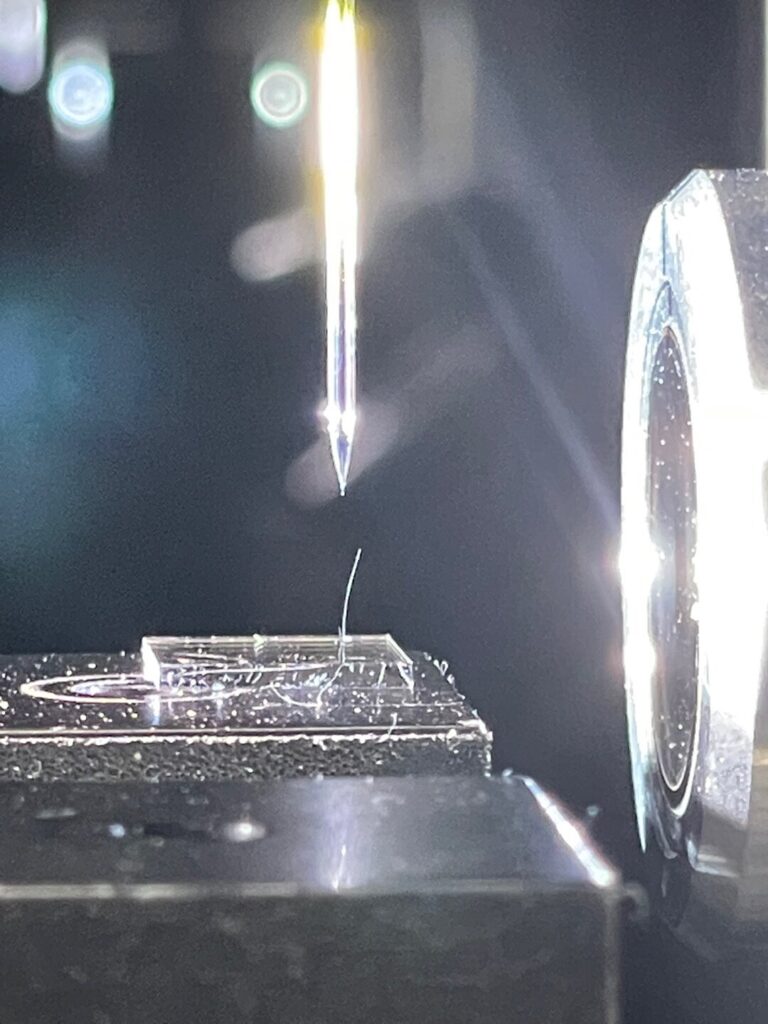The Smart 3D Printing Research Team at KERI, led by Dr. Seol Seung-kwon has developed the world’s first technology for printing high-resolution 3D microstructures using MXene, a material known as the dream material.
The work is published in the journal Small.
MXene, first discovered in the United States in 2011, is a two-dimensional nanomaterial composed of alternating metal and carbon layers. MXene possesses high electrical conductivity and electromagnetic shielding capabilities.
Due to its easy combination with various metal chemicals, MXene has gained significant attention in fields such as high-efficiency batteries and electromagnetic shielding.
However, applying MXene in the field of 3D printing requires additional additives (binders), and there has been the challenge of finding the optimal ink viscosity (concentration) to make printing possible. In other words, if the amount of MXene was too high, the high-concentration ink would clog the pipette nozzle.
Conversely, if the amount of MXene was significantly reduced, there was a limitation in being able to print the desired structures. Furthermore, the additives also had the drawback of damaging the original properties of MXene.

To solve these problems, Dr. Seol Seung-kwon’s team used their unique Meniscus method. The Meniscus effect occurs when a droplet is gently pressed or pulled with a constant pressure, causing the droplet to form a curved surface on the outer wall without bursting due to capillary action.
The researchers at KERI successfully developed a 3D printing nano ink by dispersing highly hydrophilic MXene in water without the use of a binder, enabling the printing of high-resolution microstructures even with low viscosity.
The principle of printing is simple. First, when the ink is ejected from the 3D printer nozzle, nanomaterials like MXene are sprayed out through the Meniscus, which acts as a channel. At this point, the water (solvent) quickly evaporates from the meniscus surface of the ink, and strong intermolecular forces (van Der Waals forces) cause the nanoparticles to bind together. By continuously performing this process while moving the nozzle, a conductive 3D microstructure is created.
This achievement was made by maximizing the properties of MXene without any additives, and the results were outstanding. The printing resolution was an impressive 270 times higher than existing technologies, at 1.3 µm (micrometers), which is about 1/100th of the thickness of a human hair.
The miniaturization of 3D printed structures has led to a significant improvement in the performance and applicability of electrical and electronic devices. If applied in fields such as batteries and energy storage devices, it can increase the surface area and integration density of the structures, maximizing ion transfer efficiency and boosting energy density.
If this is applied in the field of electromagnetic shielding, it can enhance performance by amplifying the internal multiple reflections and absorption effects. Additionally, when this technology is applied to manufacture various sensors, improvements in sensitivity and efficiency can be expected.

Dr. Seol Seung-kwon stated, “We put a lot of effort into optimizing the concentration conditions of MXene ink and precisely analyzing the various parameters that could arise during the printing process.”
He further remarked, “Our technology is the world’s first achievement that allows the creation of high-strength, high-precision 3D microstructures by leveraging the advantages of MXene without the need for any additives or post-processing.”
KERI plans to actively seek out companies for the commercialization of its developed technologies. Additionally, KERI’s goal is to lead the related market by utilizing nano-ink-based 3D printing technology, as the demand for ultra-small, flexible electronic devices that are not limited by physical form factors (Form-Factor Free) is rapidly increasing.


